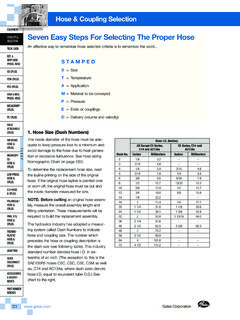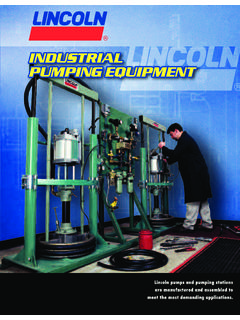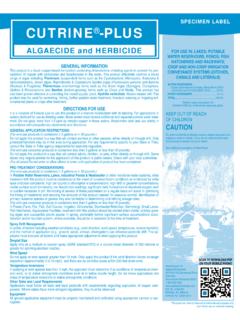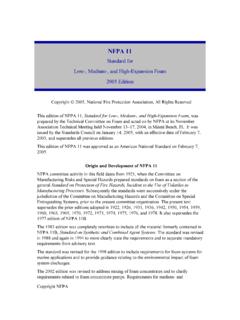Transcription of Preventive Maintenance for industrial & Hydraulic …
1 Preventive Maintenance for industrial & Hydraulic Hose Systems Chapter 1 A solid Preventive Maintenance (PM) program is critical to the safe and productive operation of Hydraulic and industrial hose systems. Hydraulic This multi-chapter Gates Fluid Power eBook will delve into the many Preventive Maintenance : advantages gained by taking proper safety precautions and identifying Establishing system weaknesses before failure occurs. It will also take a step-by- a Program step approach to hose and coupling selection, assembly, installation and troubleshooting. This initial chapter focuses on Hydraulic assemblies, introducing the reasons for establishing a PM program and outlining the necessary steps from inspection to troubleshooting to keep safe systems run- ning at maximum efficiency. Preventive Maintenance Benefits of Preventive as a Necessity Maintenance Even in the toughest economic climate, no business should From cost savings to protecting workers, every organization cut corners when it comes to Preventive Maintenance .
2 Avoid- has much to gain from a solid Preventive Maintenance pro- ing costly emergency repairs, production downtime and gram. Here are some examples: compromised worker safety is strong incentive for following Efficient production, since equipment is in prime careful Maintenance plans. operating condition. The main objective of a PM program is to identify component Better use of in-shop Maintenance personnel weaknesses before failure and loss of production. In the case with less emergency work. of hydraulics, high pressures and temperatures make hose and fitting Maintenance , as well as component selection, Improved control of spare parts inventory and particularly important. reduced parts usage. L. ess equipment downtime through scheduled inspections. Safety hazards are minimized. Increased life expectancy of equipment.
3 F. ewer capital outlays for premature purchases of new equipment. Reduced repair costs from fewer breakdowns. 1. Components of surized Hydraulic system . Serious emergencies arise and medical attention is needed when fluid punctures a PM Program the skin, even if no pain is felt. An effective PM program includes these key elements: Leak. Leaking Hydraulic fluid is not only unsightly, it Maintaining a safe work environment. is hazardous. It makes workplace floors slippery and Maintenance records. dangerous and can also contaminate the environ- Regularly scheduled inspections. ment. In fact, as little as one quart of oil can pollute up to 250,000 gallons of water, and it is estimated Troubleshooting. that 100 million gallons of oil leak from Hydraulic Proper hose and fitting selection. equipment annually.
4 Proper assembly, routing and installation. Periodic Maintenance and product training. QUICK TIP: Before cleaning an oil spill, Safety always check EPA, state and local regulations. Although establishing and maintaining a safe work environ- ment might seem like common sense, refreshing associates B. urst. Whether due to improper selection or damage, and employees on the basics will help lessen the risk of a ruptured hose can cause injury. If it bursts, a worker catastrophic outcomes. can be burned, cut or injected or may slip and fall. Pressure, temperature, flammability, mechanical parts and electricity are all factors to consider when working Coupling Blowoff. If an assembly isn't properly made or installed, the coupling could come off and hit or with Hydraulic equipment. spray a worker, possibly resulting in serious injury.
5 QUICK TIP: W. hipping Hose. If the hose end or end fitting comes apart under pressure, the loose hose can whip Society of Automotive Engineers (SAE). around with great force. This has the potential to cause recommended practice J1273 contains many useful serious injury. If this hazard exists, the hose should suggestions about design, installation, Maintenance be restrained or shielded using clamps or protective and other activities involving hose assemblies shielding. in Hydraulic systems. Stored Energy. Hydraulic systems sometimes use accumulators to store potential energy or absorb shock. This energy can create pressure that keeps a system 's Pressure components moving. Operating pressures of Hydraulic systems reach as high as 10,000 psi. With Hydraulic fluid under pressure, the follow- QUICK TIP: ing dangers are encountered: Charged accumulators can be lethal.
6 P. inhole. Fluid escaping from a pinhole can be virtually Always open the accumulator's valve invisible and yet cause serious injury. Workers must to release pressure. avoid touching and even approaching any part of a pres- Pascal on Pressure Blaise Pascal, the French scientist and philosopher, was the first to discover that a pressure applied to any part of a confined fluid transmits to every other part with no loss. The pressure acts with equal force on all equal areas of the confining walls and perpendicular to the walls. Pascal's studies centered on the principles of Hydraulic fluids led him to invent the Hydraulic press and the syringe. 2. Dose, Duration & LifeGuard Lives Up Manner of Contact to Its Name: The Sleeve Protects As a federal public health agency of the Against Hydraulic Hose Failure Department of Health and Human Services, the A pinhole leak in a Hydraulic hose under pressure can Agency for Toxic Substances and Disease Registry have catastrophic effects threatening life and limb.
7 (ATSDR) notes that many factors determine whether That is why those working with Hydraulic equipment one is harmed when exposed to Hydraulic fluids. seek out new ways to protect against toxic fluids These include the dose, duration of exposure and under pressure. the manner in which one comes into contact with it. Pole tampers, protective hoses and ordinary nylon sleeving simply do not offer the level of safety Temperature needed when lives are at risk. The LifeGuard Line- Most Hydraulic systems operate between 150 and 180 F, of-Sight Sleeving system from Gates Corporation is but some go as high as 300 F. Liquid at these temperatures, as well as metal parts, can cause burns. an unprecedented product, containing 6,000 psi bursts and 3,000 psi pinhole leaks on -four (1/4. Flammability inch), -six (3/8 inch) and -eight (1/2 inch) hose sizes With the exception of those comprised primarily of water, all up to 212 F.
8 Hydraulic fluids are flammable when exposed to the proper conditions. Leaking pressurized Hydraulic fluids may develop a Compatible with a wide mist or fine spray that can flash or explode upon contact with a range of fluids, from source of ignition. Precautions should be taken to eliminate igni- environmentally friendly tion sources, including electrical sparks, open flames, extremely liquids to biodiesel fuel, high temperatures, and hot manifolds and engine blocks. the double-layer Life- Mechanical Guard sleeving protects workers within a three-foot Swinging arms, booms, rollers, presses and anything that line-of-sight of a Hydraulic system . Its inner layer moves can be dangerous if a hose fails. For example, when is made of tightly woven, extruded filament nylon a hose bursts, objects supported by fluid pressure may fall, and vehicles or machines may lose their brakes.
9 Designed to absorb the energy of a Hydraulic hose burst or pinhole leak by stretching up to 20 percent. The outer sleeve, which is resistant to abrasion but Quick Tip: not specifically designed for abrasive environments, If equipment is mobile, always chock is a bolt-cut, air-textured nylon material that contains the tires to prevent rolling. escaped fluids and redirects them to the clamped ends of the hose. Electrical Hydraulic equipment must be turned off before it is worked The sleeve is secured at either end of the hose with on. With plant equipment, the control box should be locked special channel clamps. The clamps allow leaking and it should be tagged with a warning sign. With mobile fluid to safely escape, so it will not collect behind the equipment, the key should be removed and/or the battery sleeve and cause a burst.
10 Plus, leaked fluid allows should be disconnected so that it cannot be started. for fast hose failure detection. High-voltage power lines and underground power sources must be identified before equipment is run. OSHA standards LifeGuard sleeving has been subjected to rigorous require that all Hydraulic tools used on or near energized testing programs in the lab and in the field to power lines or equipment are supplied with non-conducting offer a true safety solution. Visit hose having adequate strength for normal operating pres- lifeguard to learn more. sures [29 CFR (f)(3)]. 3. In addition to the factors above, proper hose selection, cou- abrasion, blisters, nicks, cracks, cuts, hardness or pling selection, hose assembly and installation are all critical to color changes. Determine what is causing the damage.












